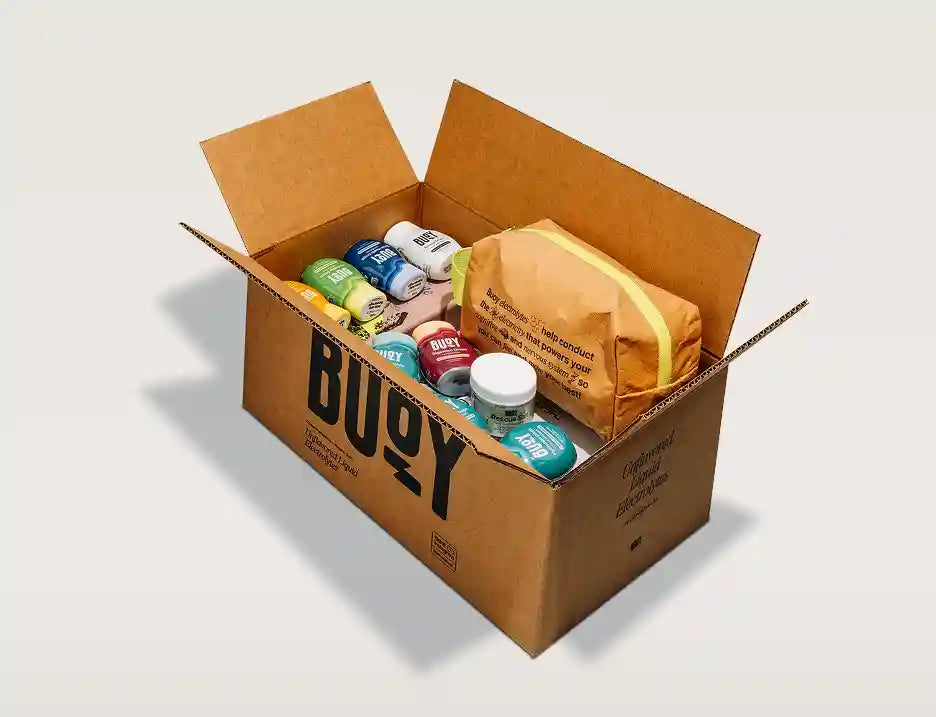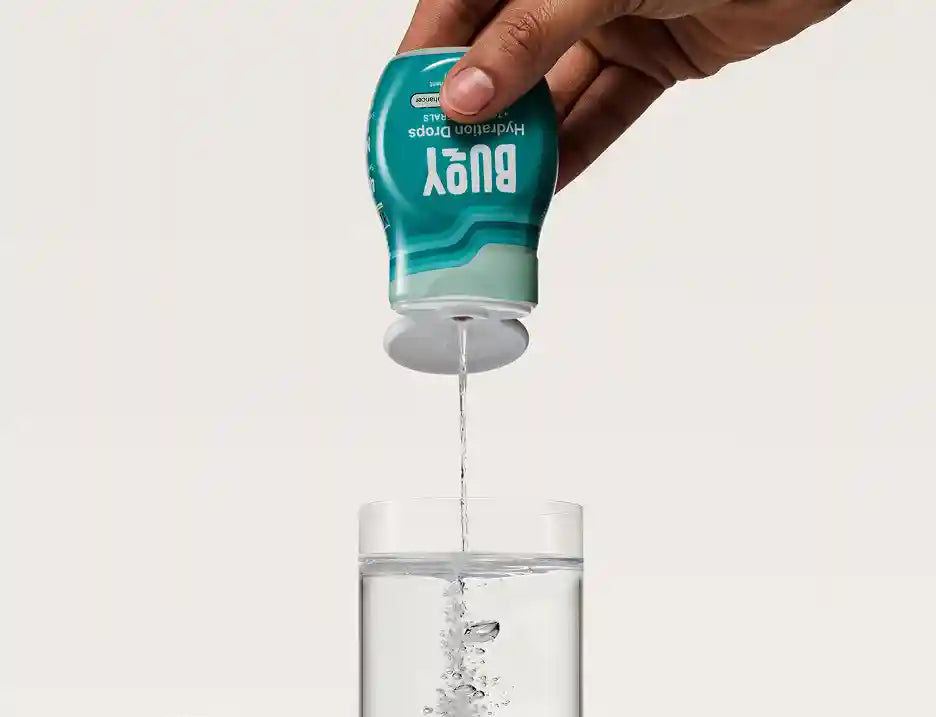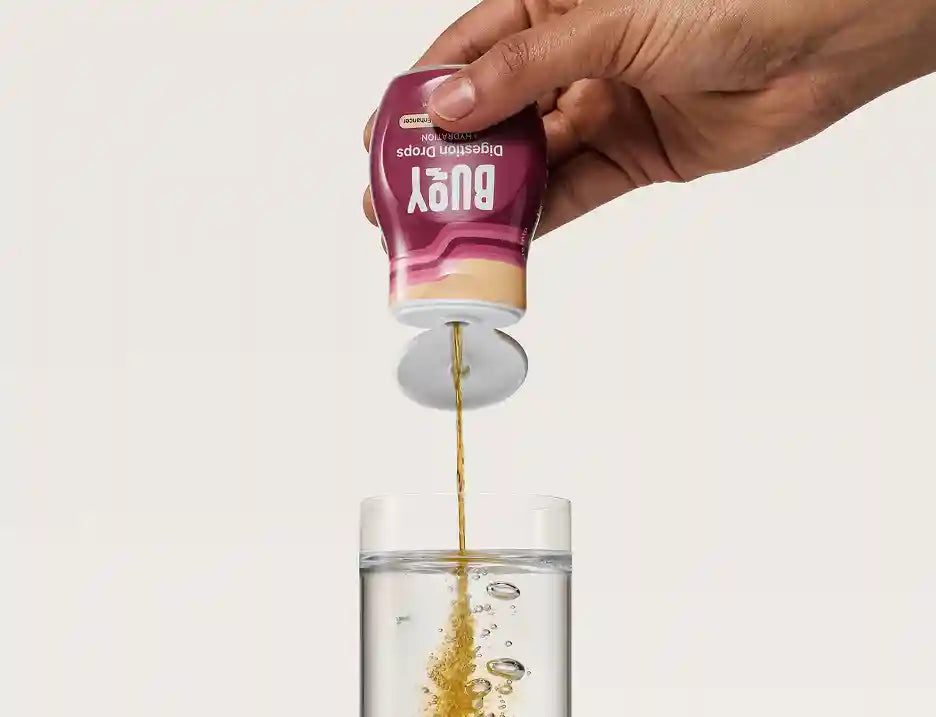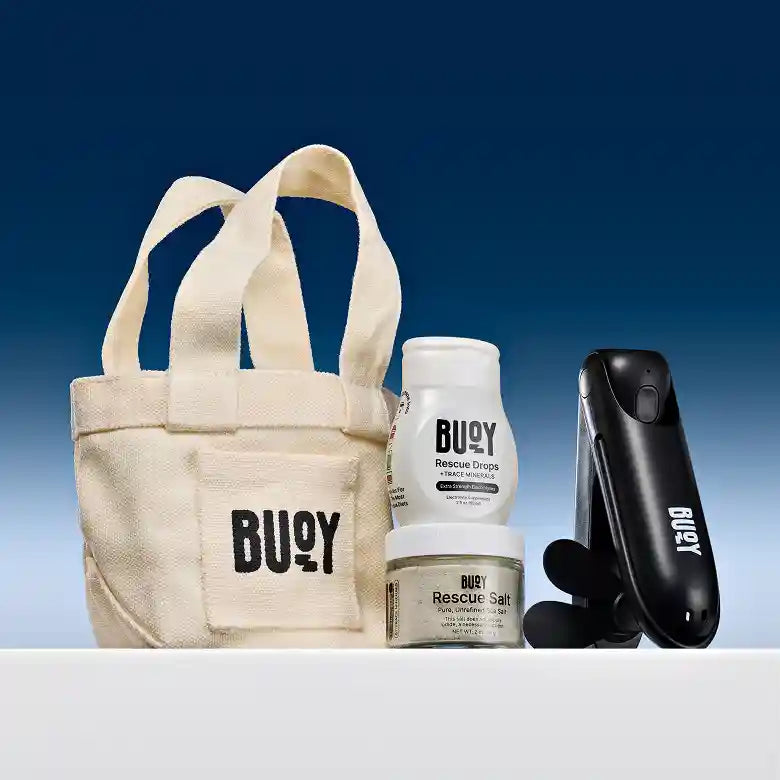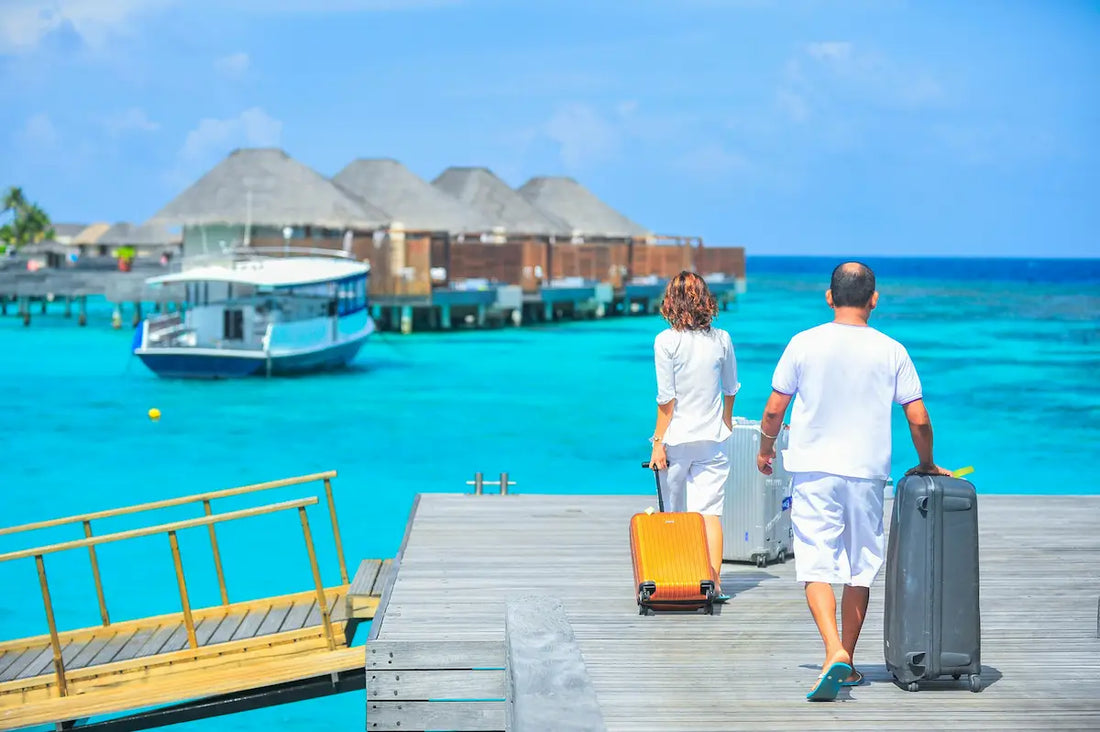
Electrolytes for Travel: Beat Jet Lag and Dehydration
Share
Whether it’s a short flight or a long-haul journey, travel takes a toll on your hydration. Airplane cabins, time zone changes, and unfamiliar foods can all throw your system off balance. The result? That drained, foggy, post-flight feeling that makes even the best destinations harder to enjoy.
Plain water helps, but often it’s not enough. Electrolytes - minerals such as sodium, potassium, and magnesium, help regulate fluid balance, nerve signals, and muscle function, all of which influence how your body manages hydration.
Quick Takeaways
- Cabin air is extremely dry, often below 20% humidity which increases insensible water loss through breathing and skin.”
- Electrolytes like sodium, potassium, and magnesium support hydration, energy, and muscle function during travel.
- Rehydrating with electrolytes may help counter dehydration-related fatigue, swelling, or headaches associated with long flights.
- Buoy Rescue Drops offer a portable, sugar-free way to rehydrate on the go.
- Start hydrating before your flight - not after you land.
Buoy Rescue Drops deliver clean, sugar-free electrolyte support designed for travel. No powders, no heavy bottles, just a few drops in your drink to keep you balanced, alert, and hydrated from takeoff to touchdown.
- How Travel Disrupts Hydration and Electrolyte Balance
- The Science Behind Jet Lag and Electrolytes
- Why Buoy Rescue Drops Are Ideal for Travel Hydration
- Travel Scenarios and Easy Hydration Wins
- Hydration Timing: Resetting Your Rhythm
- Altitude, Climate, and Environmental Stressors
- Overnight Travel and Sleep Disruption
- Packing Smart: Travel Hydration Essentials
- When to Seek Extra Support
- FAQs
How Travel Disrupts Hydration and Electrolyte Balance
The airplane cabin is one of the most dehydrating environments most people experience. Humidity levels hover around 10–20%, drier than most deserts. Every breath you exhale releases moisture, while cabin pressure and recycled air speed up fluid loss through your skin and lungs.
Coffee, tea, and in-flight alcohol compound the issue by acting as mild diuretics, increasing urine output. Add long periods of sitting, limited access to fluids, and inconsistent meal times, and your body quickly begins to lose both water and electrolytes.
Even a 1–2% reduction in body water can affect energy and reaction time, factors that may worsen travel fatigue. Without electrolytes like sodium and potassium, the water you drink may pass through your system without being properly absorbed, leaving you thirsty again within hours.
Curious how sodium really impacts hydration? Read our post "Does Sodium Really Dehydrate You?" for the science behind it
The Science Behind Jet Lag and Electrolytes
Jet lag isn’t just about sleep, it’s about your body’s circadian rhythm, hydration status, and cellular energy. Sodium, potassium, and magnesium each play a role in restoring balance after long flights:
- Sodium helps retain fluid and prevent rapid dehydration.
- Potassium balances sodium levels, reducing bloating and water retention.
- Magnesium supports energy production, calms the nervous system, and can improve sleep, helping your body adjust to new time zones.
Research indicates travelers experience fluid shifts and hormonal changes affecting electrolyte regulation during flight. Replacing both together, rather than water alone, helps your cells absorb and hold moisture, speeding recovery and reducing fatigue.
Why Buoy Rescue Drops Are Ideal for Travel Hydration
Rescue Drops are designed to make travel hydration simple and practical:
- Liquid format: No powders, mixing packets, or bulky bottles.
- Sugar-free and unflavored: No spikes, crashes, or unnecessary additives.
- Flexible dosing: Add to any drink, water, tea, sparkling water, or juice.
- Travel-friendly: TSA-compliant size, so you can bring it in your carry-on.
They replace the electrolytes you lose through dry air, altered schedules, or warm climates, without disrupting your diet or gut.
Even beyond travel, electrolytes play a crucial role in recovery. Learn more in The Best Electrolytes to Cure a Hangover.
Travel Scenarios and Easy Hydration Wins
| When It Happens | What’s Going On | Simple Fixes | When to Use Rescue Drops |
|---|---|---|---|
| Before your flight | You’re already slightly dehydrated from pre-travel prep (packing, coffee, stress). | Drink 2–3 glasses of water and add Rescue Drops to one. Eat potassium-rich foods (like a banana or yogurt). | Add drops to morning or afternoon water before you head to the airport. |
| During flight | Cabin air pulls moisture from skin and lungs; caffeine and alcohol increase loss. | Sip electrolyte water every 30-60 minutes; avoid excess caffeine or alcohol. | Add drops to your reusable water bottle before takeoff and refill during the flight. |
| On arrival | Time zone shifts and fatigue affect digestion and hydration signals. | Drink water with electrolytes, eat light meals with fruits or veggies, and get daylight exposure. | Add drops to morning water or tea to restore balance after landing. |
| Hot or high-altitude destination | Sweating or rapid breathing accelerates dehydration. | Increase fluids, rest, and choose light meals with electrolytes. | Add drops to 2-3 glasses per day while acclimating. |
| Overnight flights | Sleep disruption and cold cabin air increase dryness and fatigue. | Drink a small glass of electrolyte water before rest and again on waking. | Use Rescue Drops before and after sleeping to stay balanced. |
Hydration Timing: Resetting Your Rhythm
Consistent hydration may support comfort and energy while your body adjusts to new time zones.
- Pre-flight: Start hydrating 24 hours before departure. Use Rescue Drops once or twice to top up minerals.
- In-flight: Sip throughout the journey. Avoid long gaps between drinks.
- Upon arrival: Get natural light, walk around, and drink electrolyte-enhanced fluids during the local daytime.
- At night: Stop heavy fluid intake a few hours before bed to avoid interrupting sleep.
Combining this hydration pattern with gentle daylight exposure helps your body adapt faster to new time zones.
Altitude, Climate, and Environmental Stressors
Travel isn’t just about distance, it’s about environment. Flying at high altitudes or visiting climates that are hot, dry, or humid all change how your body manages fluids.
- High altitude: Lower oxygen levels increase breathing rate, drying out airways and speeding fluid loss.
- Dry climates: Your skin and lungs lose water quickly, even if you don’t feel sweaty.
- Humid environments: You may sweat heavily without realizing how much sodium you’re losing.
In all cases, the solution is the same: combine water and electrolytes. Start early, hydrate consistently, and rest when possible.
Overnight Travel and Sleep Disruption
Overnight flights or multi-leg journeys can be especially tough on hydration. The cabin environment reduces humidity and disrupts your body’s normal cues for thirst and rest. A few tips to stay balanced:
- Drink a small amount of electrolyte water before sleep and again after waking.
- Avoid caffeine and alcohol for several hours before rest.
- Use a light blanket, breathable clothing, and an eye mask to help the body relax.
- Move or stretch gently every couple of hours to support circulation.
Rescue Drops fit perfectly into this rhythm, providing hydration support without the sugar that can interfere with sleep quality.
Packing Smart: Travel Hydration Essentials
- Bring Rescue Drops in your carry-on for easy access.
- Carry a refillable water bottle and fill it post-security to avoid sugary drinks.
- Pack snacks with natural electrolytes - nuts, seeds, bananas, or small oranges.
- Be climate-aware: Dress for ventilation in heat and hydration-friendly layers in dry or cold air.
- Listen to your body: Headaches, dry lips, or brain fog are early signs of dehydration.
When to Seek Extra Support
If you experience ongoing fatigue, dizziness, muscle cramps, or swelling during or after travel, it may signal a more significant fluid or electrolyte imbalance. Continue hydration, but consult a healthcare professional if symptoms persist, especially if you have heart, kidney, or blood pressure concerns.
FAQs
What is travel hydration with electrolytes and why is it important?
Travel hydration with electrolytes means combining water with minerals like sodium, potassium, and magnesium to help your body retain fluids and restore balance. It’s important because travel, especially air travel, causes fluid loss through dry cabin air, increased urination, and sweating. Electrolytes help your body absorb water more efficiently, reduce jet lag symptoms like fatigue and headaches, and support overall recovery.
How can Rescue Drops help combat dehydration during flights?
Rescue Drops may help combat dehydration during flights by providing a concentrated source of essential electrolytes in drop form. This allows you to easily add them to water and maintain hydration even when cabin air is dry or food and drink options are limited. Using them hourly or as needed during your flight supports fluid retention, helps reduce bloating, and keeps your system better balanced so you feel more energized upon arrival.
When should I start using electrolytes for travel hydration?
You should start using electrolytes for travel hydration ideally 24 hours before departure. Starting early allows your body’s electrolyte stores to build up so you begin the journey with more balance. Continuing to sip electrolyte‑enhanced water during flight and after landing further supports recovery. Using Rescue Drops pre‑flight, intra‑flight, and post‑flight may minimize dehydration and jet lag.
Is plain water enough for long-haul flights?
Plain water helps, but it’s often not enough when traveling long‑haul flights. Because of low humidity, pressurized air, and extra fluid loss (from breathing, temperature, movement), you also lose electrolytes. Without replacing those, water alone may pass through your system too quickly. Electrolytes may help retain fluid in cells, so combining water with minerals - through Rescue Drops, for example - gives more effective hydration.
Can electrolyte supplements like Rescue Drops reduce jet lag symptoms?
Electrolyte supplements like Rescue Drops can help reduce jet lag symptoms. By restoring depleted minerals, they support better fluid retention, reduce headaches and fatigue, and help stabilize bodily functions that are disrupted when crossing time zones. While they don’t replace sleep or circadian rhythm reset, they act as a critical tool in helping your body recover faster and adapt more smoothly after a long journey.
Are Rescue Drops safe and practical for travel?
Yes, Rescue Drops are both safe and practical for travel. Their drop format means you can easily pack them, avoid bulky powders, and dose flexibly. The formula is clean - free from sugar, artificial colors, or fillers - reducing risk of upset stomachs or unwanted ingredients. When used as directed, they support hydration without interfering with dietary restrictions or travel routines.
References
- Healthline. (2019). Electrolytes: Functions, Imbalance, and Sources.
- Nagda, N. et al. (2011). Low Humidity in the Aircraft Cabin Environment and Its Impact on Human Well-Being. Building and Environment.
- National Academies of Sciences. (2002). The Airliner Cabin Environment and the Health of Passengers and Crew.
- Schöffl, I. et al. (2020). Up in the Air: Evidence of Dehydration Risk and Long-Haul Flight. Nutrients, 12(9):2574.
- NASA. (1976). Elevation of Aldosterone During Flight and Associated Electrolyte Changes. NASA Technical Report 76-5588.
- JAMA. (1998). Effects of Hydration on Fluid Balance and Lower-Extremity Blood Parameters During Flight.
- Sivana Bot-Barkan et al. (2021). Aviator’s Fluid Balance During Military Flight.
